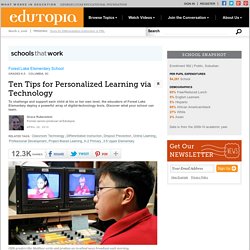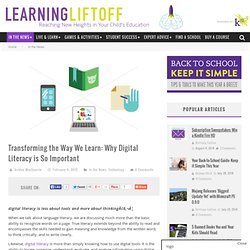

Sir Ken Robinson: Bring on the learning revolution! The 5 Resources Model of Critical Digital Literacy. The 5 Resources Model provides a framework to articulate the scope and dimensions of digital literacies.

It is based on an established model of literacy which is underpinned by critical perspectives (the Four Resources Model of Critical Literacy, after Luke & Freebody). It has been adapted for the digital context. The model has been developed to encompass the varied perceptions and meanings attributed to digital literacy. On the one hand some stakeholders put a strong focus on ICT, i.e. the skills involved in using computers, software and digitally enabled devices; others emphasise the social and interpersonal, creative and communicative skills highlighted by social media and Web 2.0; there are also critical and intellectual approaches associated with the term digital scholarship. Different stakeholders tend to emphasise different skillsets. What you will find on this site. 20 ways of thinking about digital literacy in higher education. Josie Fraser, social and educational technologist, Leicester City Council First define what you mean by digital literacy: The definition I most frequently use is this one: digital literacy = digital tool knowledge + critical thinking + social engagement.

Then it's worth knowing its main characteristics: • It supports and helps develop traditional literacies• It's a life-long practice• It's about skills, competencies and critical reflection on how these skills and competencies are applied• It's about social engagement Top tips for developing the digital literacy of non-traditional students: Begin by exploring the ways in which the group are already using mobile and web based technologies. Many of them will already be engaging with tech for personal use, for example Skyping relatives, keeping in touch on Facebook or using mobile phones. Literacy is not static: I like Bélisle's three models of literacy: functional, socio-cultural and transformational.
Planning and Designing a Blended or Online Course. Ten Tips for Personalized Learning via Technology. At Forest Lake Elementary School, in Columbia, South Carolina, the student population grows more diverse by the day.

Income levels, ethnicities, family structures, first languages, interests, and abilities now vary so much, that a traditional teaching approach, with a uniform lesson targeted to the average-level student, just doesn't cut it. (Sound familiar to you educators out there?) To challenge and support each child at his or her own level, the Forest Lake teachers and staff are deploying a powerful array of widely available digital-technology tools.
Each classroom is equipped with an interactive whiteboard and a Tech Zone of eight Internet-enabled computers. Plus, teachers have access to gadgets including digital cameras, Flip cameras, remote-response clickers, and PDAs. More important than the gadgets themselves, of course, is how the teachers use them to create personalized lessons and a productive environment where each child is engaged. 1. 2. 3. 4. 5. Select teaching technology with SECTIONS. As the demand for eLearning grows, we see more teachers turning to technologies to support or deliver their teaching.

Good guidance in the selection of the appropriate technologies is often missing. All too often, we see teachers falling for the glossy technologies and spending time and money pursuing them at the expense of the learning of their students. Select teaching technology with SECTIONS. Transforming the Way We Learn: Why Digital Literacy is So Important - K12 - Learning Liftoff - Free Parenting, Education, and Homeschooling Resources. Digital literacy is less about tools and more about thinking… When we talk about language literacy, we are discussing much more than the basic ability to recognize words on a page.

True literacy extends beyond the ability to read and encompasses the skills needed to gain meaning and knowledge from the written word, to think critically, and to write clearly. Likewise, digital literacy is more than simply knowing how to use digital tools. It is the ability to locate, organize, understand, evaluate, and analyze information using digital technology. It’s also about knowing what to share and who to share it with. In other words, it is less about tools and more about thinking. Skills based on using digital tools are important, but they are also short-lived since the tools and platforms available to us change so quickly.
In fact, though we refer to modern kids as digital natives, the idea that young people are more inherently digitally literate is false. Update: This series has ended. 1.